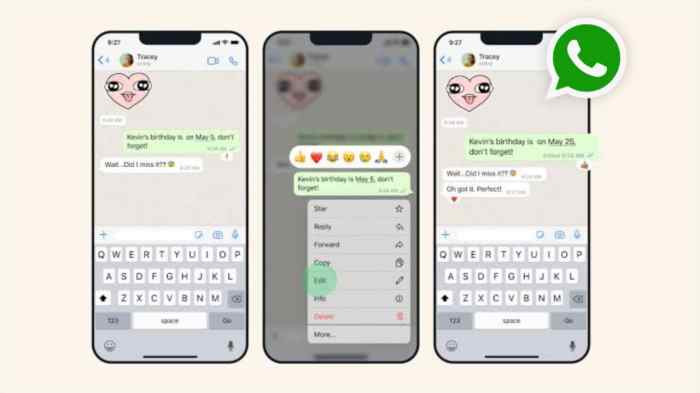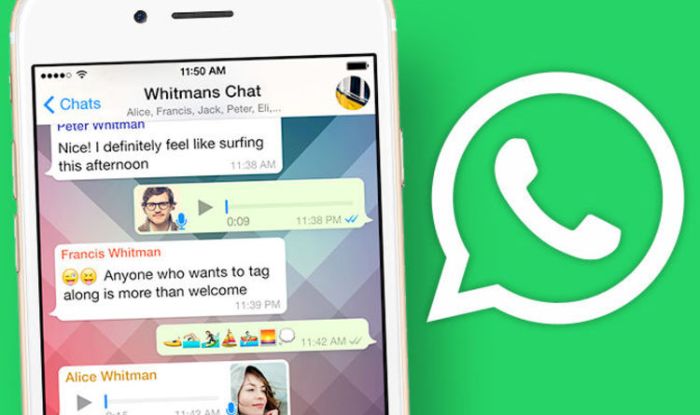How to edit WhatsApp messages once they are sent has emerged as a highly sought-after feature, igniting discussions among users and developers alike. This article delves into the technical challenges, potential solutions, and user interface considerations associated with implementing message editing in WhatsApp.
As we navigate the complexities of message encryption and delivery status, we explore innovative workarounds and analyze their feasibility. We also examine the potential impact on communication dynamics and user behavior, considering both the benefits and risks associated with message editing.
Overview of WhatsApp Message Editing Feature
WhatsApp, the popular instant messaging platform, has introduced a much-anticipated feature: the ability to edit sent messages. However, this feature comes with certain limitations that users should be aware of.
Previously, WhatsApp users were unable to edit messages after sending them, which could lead to frustration and misunderstandings. The new editing feature addresses this issue, allowing users to correct errors, clarify their thoughts, or add additional information to their messages.
Limitations of WhatsApp Message Editing
- Time Limit:Users have a limited time frame of 15 minutes to edit a sent message. After 15 minutes, the editing option becomes unavailable.
- Notification to Recipients:When a message is edited, all recipients of the message will receive a notification indicating that the message has been edited. This transparency ensures that recipients are aware of any changes made to the message.
- Message History:Edited messages will retain their original timestamp, but a small “Edited” label will be displayed beneath the message to indicate that it has been modified.
Technical Challenges in Implementing Message Editing
Introducing the ability to edit messages after they’ve been sent on WhatsApp presents several technical challenges that need to be addressed to ensure a seamless and secure user experience.
Message Encryption
WhatsApp employs end-to-end encryption, which ensures that messages are encrypted on the sender’s device and decrypted only on the recipient’s device. This encryption mechanism poses a challenge in implementing message editing, as the edited message would need to be re-encrypted and sent to the recipient, potentially breaking the encryption chain.
Message Delivery Status
WhatsApp displays message delivery statuses, such as “Delivered” or “Read,” to indicate the message’s status. Allowing message editing after delivery could lead to confusion and potential security concerns, as the recipient may have already acted upon the original message before it was edited.
Security Concerns
The ability to edit messages after they’ve been sent raises potential security concerns. For example, malicious actors could exploit this feature to spread misinformation or alter the content of sensitive messages after they’ve been read by the recipient.
Potential Solutions and Workarounds

Users and developers have proposed various solutions and workarounds to enable WhatsApp message editing after sending. While some offer potential feasibility, others have limitations or drawbacks.
It is important to note that WhatsApp does not currently support message editing, and any workaround or solution may not be officially endorsed or supported by the platform. Additionally, implementing these solutions may require technical expertise or involve third-party applications.
Third-Party Apps
Some third-party applications claim to offer message editing functionality for WhatsApp. These apps typically work by intercepting sent messages and modifying them before they reach the recipient. However, these apps may not be reliable, secure, or compatible with all devices and WhatsApp versions.
Message Recall
WhatsApp’s message recall feature allows users to delete sent messages within a limited time frame (currently set to 1 hour, 8 minutes, and 16 seconds). While this does not directly enable message editing, it provides a way to correct or remove erroneous or inappropriate messages after they have been sent.
Edited Message Forwarding
Another workaround involves forwarding the message to oneself and editing it before resending it to the intended recipient. This method allows for limited editing capabilities, such as adding or removing text, but it may not be suitable for all situations.
Message Replacement
Some users suggest sending a new message with the corrected or edited content and asking the recipient to disregard the original message. While this approach is simple and straightforward, it may not always be practical or convenient, especially in situations where the recipient has already read the original message.
Feature Request
Many users have expressed their desire for an official message editing feature within WhatsApp. Submitting feedback or feature requests to WhatsApp through the app or other channels can help convey the demand for this functionality. However, it is ultimately up to WhatsApp to decide whether and when to implement such a feature.
User Interface Considerations
Designing a user-friendly interface for message editing in WhatsApp is crucial to ensure a seamless user experience. Various scenarios and user preferences should be taken into account during the design process.
Intuitive editing tools and features can significantly enhance the user experience. For example, a simple tap-and-hold gesture could reveal an editing menu with options like “Edit,” “Delete,” and “Forward.” Additionally, a dedicated “Edit” button within the chat window could provide quick access to editing functionality.
Editing Options
- Edit: Allows users to modify the content of their sent messages.
- Delete: Provides the option to remove sent messages from both the sender’s and recipient’s devices.
- Forward: Enables users to share sent messages with other contacts or groups.
Impact on Communication and User Behavior: How To Edit WhatsApp Messages Once They Are Sent

The introduction of message editing in WhatsApp has the potential to significantly impact communication dynamics among users.
One of the key advantages of message editing is that it allows users to correct mistakes, clarify their thoughts, or add additional information to their messages. This can lead to improved message clarity and reduce misunderstandings, especially in situations where messages are sent quickly or without sufficient context.
Accountability and Trust
However, message editing can also raise concerns about accountability and trust. If users are able to edit their messages after they have been sent, it may become more difficult to hold them accountable for the content of their communications.
For example, a user may send a message that is offensive or misleading, and then later edit it to remove the objectionable content. This could make it difficult for the recipient to prove the original content of the message, potentially undermining trust between users.
Additionally, message editing could make it easier for users to spread misinformation or engage in other forms of online harassment, as they could simply edit their messages after the fact to avoid detection.
To mitigate these concerns, WhatsApp may consider implementing features that allow users to track the history of message edits, or to limit the amount of time that messages can be edited after they have been sent.
Ethical and Privacy Concerns
Message editing on WhatsApp raises ethical concerns about altering or deleting messages after they have been read by recipients, potentially changing the context or meaning of conversations.Privacy implications also arise, as edited messages may not be immediately apparent to recipients, leading to confusion or mistrust.
To mitigate these risks, WhatsApp could implement features such as time limits for editing, clear notifications of message edits, and audit trails to track changes.
Ethical Concerns
* Editing messages after they have been read can alter the context of conversations, potentially misleading recipients.
Deleting messages can erase evidence of previous communication, raising concerns about accountability and transparency.
Privacy Implications, How to edit WhatsApp messages once they are sent
* Edited messages may not be immediately apparent to recipients, creating confusion or mistrust.
Lack of transparency about message edits can undermine trust and privacy in communication.
Potential Solutions
* Time limits for editing: Restricting the time frame for message editing can prevent significant alterations after messages have been read.
Clear notifications of message edits
Notifying recipients of message edits ensures transparency and awareness of changes.
Audit trails
Maintaining a record of message edits provides a historical record for accountability and dispute resolution.
Final Conclusion

Ultimately, the implementation of message editing in WhatsApp requires a careful balance between user demand, technical feasibility, and ethical considerations. As the technology continues to evolve, we can anticipate further developments and advancements in this area, empowering users with greater control over their WhatsApp communication.
Query Resolution
Can I edit WhatsApp messages after they have been delivered?
Currently, WhatsApp does not offer a direct way to edit messages after they have been sent and delivered.
What are the potential security risks associated with message editing?
Message editing could potentially allow users to alter or delete messages after they have been read by recipients, raising concerns about accountability and trust.
How can I work around the limitations of WhatsApp message editing?
Some users have suggested workarounds such as using third-party apps or recalling messages before they are delivered, but these methods have their own limitations and drawbacks.

3 thoughts on “Edit WhatsApp Messages: Unleashing the Power of Post-Sending Revisions”